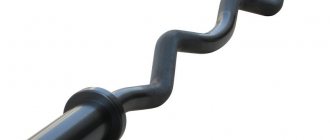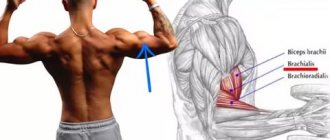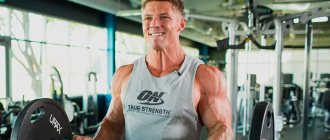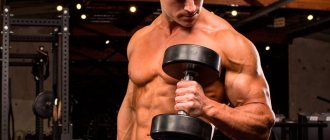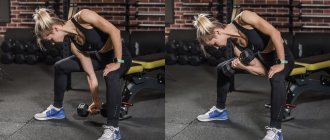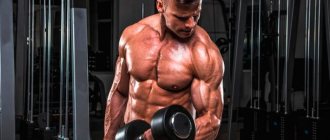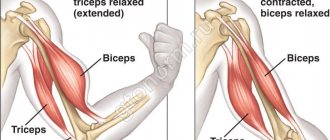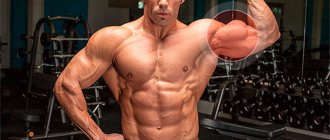For many guys and girls, the biceps is a problematic muscle. He doesn’t want to grow big, show his peak, and especially not engage in exercises that require bending his arms. Yes, many people still do cheat curls. But spider biceps curls are designed to correct this. This is one of the isolating exercises in which it is physically impossible to work in such a way that the muscles of the back, legs and core are involved. The maximum “part-time work” is the movement of the forearms, but this is also kept to a minimum, because the athlete lies face down on an inclined bench. This exercise is part of the bodybuilding arsenal, but it will also be useful for anyone who is seriously passionate about fitness and wants to pump up their biceps.
Execution technique
Initial position
- We raise the support of the Scott bench to the maximum height;
- We place the barbell on the seat;
- We stand up so that we can lie on our stomach on the support;
- We stretch our arms;
- The assistant delivers the barbell into straight, outstretched arms;
- The athlete grabs the bar so that one palm faces the other
Movement
- Start of the movement - with soft, slightly bent (not inserted) elbows;
- By contracting the biceps, the athlete brings the barbell to the forearms, bending the arms at the elbow joints;
- Lowering is slow and controlled;
- The number of repetitions is determined by the training plan
Errors
- Inhale while bending the elbows, during the effort phase;
- Exhale while extending your arms;
- Holding your breath;
- Movements with your back, allowing you to lean backward along the trajectory;
- “Part-time work” with legs;
- “Insertion” of the elbows at the lowest point, excessive extension of the elbows;
- Sliding with stomach and legs;
- Changing the position of the neck - nodding the head;
- Elbow position shift
Adam Kozyra-Spider Bending
Protein day menu
After losing weight, to consolidate the result and maintain harmony, it is useful to arrange a protein fasting day once a week. On protein days you need to eat every four hours and drink 2 liters of water per day. There are many developed one-day protein menus.
Here are just a few of them:
- Fish day - 400 g of lean fish divided into five servings. Add vegetables without oil to the fish. Drink kefir before going to bed.
- Meat day - 400 g of any lean meat, divided into five servings. Add vegetables or a side dish of legumes to the meat.
- Curd day - eat 150 grams of cottage cheese four times a day with the addition of 1-2 tablespoons of bran soaked in boiling water.
Before carrying out protein days or weeks, you should consult your doctor to avoid negative consequences. People with liver, kidney and heart diseases should not be overly fond of protein foods.
Recommendations
- You need to inhale while lowering the barbell. This is a little unusual, but corresponds to the concept of exhaling with effort. You should breathe slowly through your nose; when performing movements resting on your stomach, you should not inhale and exhale through your mouth;
- Beginners are advised to learn this movement only with a curved bar. The straight may be a good choice for those who want to engage the brachialis more and perform the exercise with a reverse grip, but not for beginners. The curved bar removes some of the load from the ligaments and makes the exercise less traumatic;
- An option with dumbbells is also possible, when the exercise is performed with a hammer grip; it is suitable for those beginners who feel shoulder pain during the exercise;
- The movement should be smooth, you can count to yourself in three counts, lowering the projectile, and just as slowly return it back;
- This movement is for isolating the biceps, and not for demonstrating remarkable strength potential. Beginners should start with the minimum weight that they can lift; intermediates can increase the weight, but within reasonable limits, choosing a barbell so that its weight does not interfere with performing the exercise technically;
- If there is no Scott bench, or it is not possible to perform it on it due to the anthropometric characteristics (height) of the athlete, it is worth doing the exercise on a regular inclined bench, sitting on it a little higher than for performing rows to the belt with support on the bench;
- Your legs should rest firmly on the floor, but you can bend them slightly at the knees;
- Spider curls are a zero-amplitude movement. You should not fully extend your arms, and perform it in such a way that you get a swing of the body or arms;
- The body must be fixed and it must not move from right to left along the bench;
- Hands should be held steadily, without changing the position of the elbows during movement. If your elbows move, this is a sign that the weight chosen is too heavy.
Afterword
Another technical note has come to an end, today we talked about the traction of the upper block.
Now you have one more tool in your spinal arsenal of exercises, which means that it will look better. Therefore, we blow into the hall and put the theory into practice. Are you here now. ). PS. Do you use overhead pulls in your back workout?
P.P.S. Did the project help? Then leave a link to it in your social network status - plus 100 points to karma, guaranteed.
With respect and gratitude, Dmitry Protasov.
Grasp the handle attached to the cable running through the top block of the cable machine; pull the handle toward your chest.
See full list of back exercises
Preparation and starting position
Before using the machine, check the cable and connections to ensure they are in good condition. If the cable breaks or the connection breaks while you are pulling the handle towards you, you may be injured.
Sit on the exercise machine. The cable should be vertical throughout the exercise or slightly angled toward your torso. Secure your hips to the T-shaped support. Don't forget to adjust its height to suit you.
If there are no such stops, then you will need to find another way that would not allow you to come off the bench and the floor. While you are sitting, a barbell of sufficient weight can be lowered onto your knees. To do this, your hips must be below your knees, otherwise the barbell will roll down. You can hold a heavy dumbbell between your legs and place it vertically. Or you can hang a heavy pancake from your belt. Or, someone may press on your shoulders - however, this method, as a rule, is not liked by the person doing the exercise. As another option, you can do the exercise from the floor, kneeling on something soft, and rolling a heavy barbell onto the back of your calves. If you select plates of the appropriate diameter, the bar will “attach” you to the floor.
The lat pulldown can be performed using different handles and different types of grip. Use a handle and grip that allows you to perform the movement with the heaviest weight and the fullest but safest range of motion. Using a straight handle, start with a supinated, shoulder-width grip. Then you can fine-tune the grip width and hand position, which will provide the greatest comfort for the wrist and elbow joints. Or, use a supinated grip and a handle that has a flat middle and the ends of which are curved slightly upward and slightly towards you. Or, use a parallel grip and an appropriate handle (see chapter “Seated Rows”).
As for the parallel grip, a shoulder-width parallel grip is better than a narrow parallel grip. You need to grasp the handle symmetrically. When doing the exercise with a parallel grip, you will have to reduce the weight compared to a supinated grip.
If a supinated grip is uncomfortable for you, and there are no handles for a parallel grip at shoulder width, try grabbing a straight handle with a pronated grip. Grip 5-7.5 cm wider on each side compared to a shoulder-width grip so that your forearms are vertical in the shortened position. For parallel and supinated grips, use a width that allows you to keep your forearms parallel to each other throughout the exercise. Regardless of which handle you prefer, never use a very wide grip and never pull the handle behind your head.
Apply chalk to your palms. However, if the handle you are using has a smooth surface, then chalk will not be of much help to you. It is better to take a handle that has a notch. To prevent your hands from slipping off the slippery handle, hold a small, palm-sized piece of neoprene between it and your hand.
Starting position for lat pull-down.
Exercise options
- Spider curls on a regular incline bench, as described above;
- Bending on a special “Spider Curl” bench, not all gyms have it; in most you have to make do with ordinary equipment;
- Bent over barbell curls without belly support. Can be practiced by experienced athletes who have minimalist gyms and have the skill of keeping their back motionless in an incline;
- Straight bar curls. Anatomically, they are not a natural movement; they are used to develop the muscles of the forearm to a greater extent;
- Reverse grip curls. Another option for a not very natural movement, which is used in bodybuilding for the sake of large and powerful forearms.
Spider curls with dumbbells on an incline sk_1.mp4
Leshchanova Evgenia
Gym instructor
Drawing up individual programs, strengthening muscles after injuries, strength training, improving general physical fitness, restorative gymnastics after childbirth. Education: College of Physical Education and Sports. Faculty: physical education teacher and rhythmic gymnastics coach. Achievements: Master of Sports in rhythmic gymnastics. Group program instructor. 8 years of experience in fitness. Over 17 years of personal training experience. Over 17 years of experience working with clients. Participant of “World Class” fitness conventions.
Analysis of the exercise
The movement is a single-joint isolating movement, used to work out the internal bundle of the brachialis and the biceps brachii muscle, that is, the biceps. There is an opinion that the movement is intended more for the brazialis, and less for the biceps.
Working muscles can be divided into two large groups:
- Movers - biceps and brachialis;
- Auxiliary muscles - anterior deltoids, triceps as stabilizers, “grip muscles”, that is, palms;
The exercise is reminiscent of classic curls, but isolates the biceps to a greater extent, so it is used only for the purpose of pumping it up.
Who is it for?
Spider curls are intended for those who do not naturally have strong biceps peaks. If an athlete values aesthetics more than strength, then he should pay attention to this movement and an exercise such as the biceps curl on a Scott bench.
Spider curls are not a power movement; they only affect the strength of the biceps, and then quite indirectly. They are used in the training of armwrestling athletes, as well as those who compete in the “strict biceps curl” discipline. In the training of these groups of athletes, exercises are performed at the end of the session.
The exercise can also be performed by women; it works especially well for those whose arms are disproportionately thin. The movement usually does not make the arms huge, it simply emphasizes the biceps that are given by nature. This also helps to “tighten the skin,” especially for those who cannot achieve elastic arms by working the triceps alone.
Common mistakes
- Excessive bending of the arms, also known as lifting the barbell “all the way”, is best done without extremes;
- Excessive arm extension, “elbow insertion”;
- Cheating with the body;
- Excessive fixation of the projectile at the top point leads to sprain of the elbow joint ligaments;
- Dangling Elbows
Recommendations
- The weight of the barbell should not interfere with the exercise. If an athlete cannot start in any way, as if by cheating, he should take a smaller barbell;
- At the same time, the exercise should not be performed in an “aerobic” mode; you need to use muscle strength, and not just inertia;
- The movement should be done at the end of the workout, and not as the first strength exercise, so there is less risk of injury;
- It is better to perform the exercise with a warm-up approach, this will allow you to soberly assess your strength and avoid injury due to insufficient warming up.
Nuances
Grip plays a big role. A reverse or pronated grip allows you to shift the emphasis to the brachialis, while a straight or supinated grip allows you to focus on the biceps. In any case, it is recommended to hold the barbell tightly and, if necessary, use magnesium to prevent the projectile from slipping out of your hands.
Increased efficiency
You can increase the contractile activity of the biceps if you do not fully extend your arms and insert your elbows, or bend your arms completely and bring your palms to your shoulders, thereby removing some of the load from the biceps.
The walking exercise technique is what you need to do with a barbell if you don’t want to take the load off the target muscle.
Tips for maximum efficiency
- Before performing any biceps exercises, you should perform a set of WARM-UP EXERCISES. The main attention should be paid to the elbow joints.
- This exercise is not competitive, so there is no need to set strength records in it. The best solution is to focus on the technique of the exercise and the work of the biceps.
- This exercise is isolated, so it is not advisable to perform it at the beginning of arm training. It's best to leave room for it at the end after the basic curls.
- Biceps are more susceptible to development when working in a high-repetition mode. Therefore, it is recommended to perform spider curls in 3-4 sets of 12-15 repetitions each.
- For more complete development of the muscles of the front of the shoulder, it is worth changing the grip from supinated, to pronated or neutral and work on the brachialis.
- To understand which of the described options is right for you, you should try them all in practice.
Spider curls are rightfully one of the exercises in biceps training. The main thing is to choose the right working weight, choose the weight with which you will work and master the technique. Then achieving an expressive shape of the biceps, in particular its peak, will only be a matter of time.
Good luck to everyone in your training!
Concentrated biceps curl
| Effect on muscles: Biceps: Shoulder Biceps: Long Bun advertising is not displayed Biceps: Short bun Forearm: Brachioradial |
Description
Concentration curls are the best exercise if your goal is to create a more convex and defined shape in the middle of the biceps.
The movements worked in this exercise are movements used in most sports. Therefore, your athletic performance will depend on this exercise. Also, do not forget that, in many respects, the strength of your biceps determines how intense and effective your chest and back muscle training will be.
Exercise technique
Sit on the edge of a bench and grab a dumbbell with an underhand grip with your right hand. Spread your legs much wider than your shoulders, press your feet to the floor as tightly as possible. The starting position will be when you lean forward and rest on the inner part of your right thigh, the lower part of your right triceps. Place the palm of your left hand on your left thigh (you can also lean on your side or knee), and bend your right arm slightly at the elbow.
Raise the dumbbell to your chest, straining your biceps, having overcome the most difficult part of the lift - exhale slightly, before starting the repetition - take a deep breath and hold your breath. When the dumbbell is at the top and almost touches your chest, pause briefly and tighten your biceps. Then slowly lower the dumbbell while exhaling.
You need to pause and tighten your biceps even more when the dumbbell almost touches your chest, this will make the exercise more effective. Don't help yourself with your whole body, only your biceps should work. After finishing the approach with your right hand, repeat the same with your left.
Recommendations
Throughout the entire duration of the exercise, the lower triceps of the arm in which the approach is being performed should be pressed against the inner thigh and not move. It is necessary to take a deep breath and not exhale until the end of the lift. This will make it much easier to keep your spine in the correct position and also make it possible to lift heavier weights.
In order for all three muscles - the elbow flexors (brachioradialis, biceps and brachialis) to be used as much as possible, do the exercise with a neutral grip. The load will be focused on the biceps if you do the lift with a twist at the wrists as you move. In this case, the palm will be in a vertical plane when you are at the bottom and look up when you are at the top. When lowering the dumbbell, rotate the hand in the reverse order.
Forearms
Apart from the titanic biceps and triceps, no other muscle group is shown off as regularly as the forearms. Made up of many individual muscles, the forearms are notoriously difficult to train. Given their involvement in almost all exercises, for accentuated training we must load them with both a large working weight and a maximum training volume. The exercises below will help you build powerful and impressive forearms in no time.
Holding discs with your fingers
Isometric training (statically holding a contraction for 10 seconds or more) is an effective way to develop muscle endurance and provides a fantastic muscle burn. By exposing the forearms to similar effects, we can achieve truly outstanding results. Holding discs with your fingertips is a classic and simple example.
Grasp two identical disks (of the same mass and size) between your thumb and fingers. With your arms straight, hold them above the floor for at least 30 seconds, then rotate your arms 180 degrees. Flatter pancakes are more difficult to hold, so it's worth experimenting with discs of different thicknesses.
Lifting a dumbbell with one hand behind your back
Most of the muscle mass of the forearms falls on the flexor muscles located on the inner surface. But instead of training them with traditional underhand curls, try doing overhead curls. This unconventional movement will work your forearms more effectively and produce better results.
Take dumbbells with an overhand grip and extend your arms completely behind your back, slightly wider than shoulder-width apart. Keeping your arm still, flex your wrist and lift the weight toward your forearm flexors; Tighten your muscles at the top. Slowly lower the weight and repeat the exercise.
Overhand grip barbell curl
Place in the ranking of authors: out of competition
(become an author)
Date of:
2012-05-29
Views:
176 401
| All articles by the author >> |
Articles are loading...
| medals : | more than 100 thousand |
Why medals are given to articles:
| Bronze medal: |
| 1. The article is included in the TOP 100 2. The article has more than 100 3. The article has more than 100,000 |
| Silver medal: |
| 1. The article is in the TOP 50 2. The article has more than 500 3. The article has more than 500,000 |
| Gold medal: |
| 1. The article is in the TOP 10 2. The article has more than 1,000 3. The article has more than 1,000,000 |
Main muscles - biceps, forearms
Additional - shoulder
Difficulty of execution: easy
For men: 10 - 15 repetitions 15 - 20 kg. 2 - 3 approaches.
For women: 10 - 15 repetitions 7 - 10 kg. 2 - 3 approaches.
Load by muscle group
The load is indicated on a 10-point scale (the total load is summed up)
| Forearms | 10 (high) |
| Biceps | 4 (average) |
| Total load/exercise type | 14 (weak) / isolated |
Description of the exercise
Main features
1. This exercise is aimed primarily at training the forearms, and then at training the biceps.
2. The grip should be shoulder-width apart or slightly narrower. If you use a curved bar, you will work your forearm a little less and your biceps a little more.
4. It is advisable not to keep your elbows in place, but to move them slightly forward when lifting the barbell. But only a little. In order to contract the biceps more strongly.
6. Set the weight so that you can do at least 8 repetitions.
7. This exercise fits perfectly at the end of an arm workout. You can “finish off” both biceps and forearms in one fell swoop.
Similar exercises
Seated barbell wrist curl
The load is indicated on a 10-point scale (the total load is summed up)
| Forearms | 10 (high) |
| Total load/exercise type | 10 (weak) / isolated |
Seated wrist extension with barbell
The load is indicated on a 10-point scale (the total load is summed up)
| Forearms | 10 (high) |
| Total load/exercise type | 10 (weak) / isolated |
Rate the material:
| SHARE | WE ARE IN SOCIAL NETWORKS |
Best articlesNew articles
This is interesting: Wrist extensions: technique of execution, anatomy of the forearms and practical recommendations for performing wrist extensions
Triceps
The triceps muscle accounts for two-thirds of the size of the upper arm, so the triceps tend to require more work than the biceps. In the era of the craze for cable rows and dumbbell curls, many old-fashioned, but very productive triceps movements have fallen into oblivion. Meanwhile, the triceps responds perfectly to any extension movements performed with dumbbells, since dumbbells provide a greater range of motion compared to a barbell.
French bench press with dumbbells
The French Dumbbell Bench Press will force you to resist gravity while locking your arms into the shoulder joint. The movement can be performed with a barbell, but the option with dumbbells and palms facing inward is more effective in terms of isolating the triceps, which contributes to a more productive gain of muscle mass.
Lie on a bench with your arms extended forward, palms facing inward. Slowly lower the dumbbells until they touch your forehead. Pause for a second, then straighten your arms and contract your triceps.
For maximum effect, it is important to keep your elbows motionless and control every centimeter of the dumbbells' trajectory.
Seated overhead dumbbell extensions with reverse grip
This heavy overhead extension targets an area of the triceps that often lacks our attention. The exercise is not easy to perform, so many people avoid it and end up suffering from inadequate muscle development.
Sit on a bench, grab the dumbbells with an underhand grip - like a biceps curl - and extend your arms up until the dumbbells are above your head. Keeping your back straight, slowly lower the dumbbells toward your trapezius until your arm is bent to 90°. After a second pause, tighten your triceps and lift the dumbbells to the starting position. Make sure your arms are turned out and don't let your elbows fall forward.
Parallel bars push-ups
Considered potentially injury-prone and less beneficial than other movements, parallel bars are gathering dust in the dustbin of history. Meanwhile, if performed correctly, they will help you gain maximum muscle mass on the back of your arms thanks to the ability to squeeze all the juices out of all three heads of the triceps. To perform this exercise correctly and safely, hang between two parallel bars and use your triceps to lift yourself to the starting position with your arms almost straight (without full elbow extension). Slowly lower your body down, keeping your elbows close to your body and your legs slightly behind, until your upper arms are parallel to the floor. To make sure you are on the right track, the angle between your shoulder and forearm will help you, which should reach 90°.
How to organize training correctly
The training is best composed of basic exercises aimed at engaging and working the entire delta. A separate bundle should be inflated only when the load placed on it was not enough and it began to lag behind the rest in development. In other cases, isolation exercises are not necessary.
You can train both in the gym and at home. The main thing is that the athlete has equipment such as dumbbells and a barbell at his disposal. The weight is selected so that at least eight or ten lifts can be done in one approach. Using too much weight to give your shoulders definition and width is not recommended. Increasing loads, that is, working with heavier equipment, should be done when the main goal is to increase muscle strength. In this case, you need to lift the shells from five to eight times, perform four to five sets.
Beginner athletes are recommended to master and perfect the execution of one or two basic presses to the point of automaticity. They perfectly work the deltoid muscle and provide an even load on the entire shoulder girdle. When it is sufficiently trained, it becomes noticeable which of the beams requires more work. At this stage, you can add isolation exercises to the training, which are chosen depending on which muscle group needs additional work.

